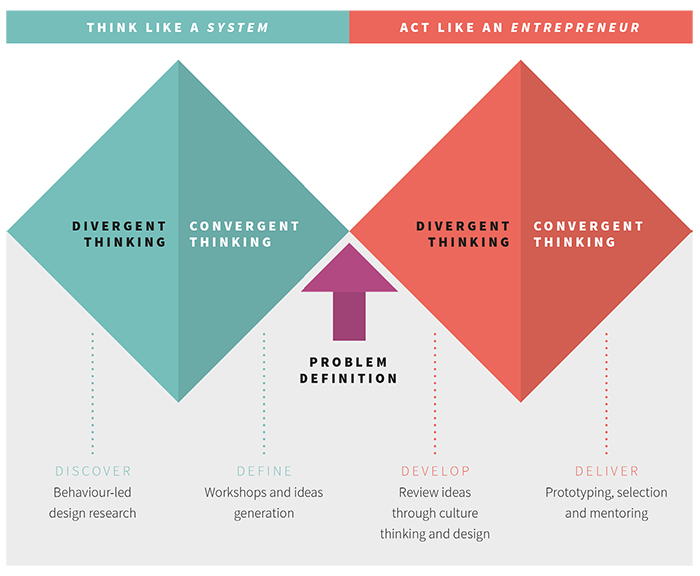After a prolonged adolescence where style perhaps outweighed substance, design thinking has grown up. Now is the time to combine design methods with systems thinking to enable the adaptive and innovative institutions we need for the future.
We live in disorienting and challenging times. As society becomes more networked, the traditional centralised power of governments is under pressure. It’s a tough time to be a political leader attempting to deploy tried and tested tools when society no longer behaves in tried and tested ways. Those formal, linear, definitive strategies that once cascaded down from a central point are now under continuous challenge by a youthful networked power that is digital by default and quick to adapt to change.
Design thinking was born of this youthful zeal and the last 10 years has seen a profound shift in what we understand as design. Driven by the exponential growth of the social web and digital services, designers have gone beyond the classic understanding of design as producer of artefacts, into design as creator of services, policies, processes, business models and governance structures.
Human-centred design thinking methods — and service design in particular — have infiltrated business, government and third sector institutions and reinvented the way they approach innovation. And this in turn is disrupting traditional notions of how policy-making, business development, R&D, organisational design and strategy are done.
As this diagram from Lean Ventures shows, rather than providing a clear route to a single solution, design thinking methods lead to many solutions, stimulating creativity and idea generation that arrive at a variety of innovation types.

Design thinking and social challenges
In a report on social innovation, the Rockerfeller Foundation suggested that this type of creative thinking is critical if society is going to respond deftly enough to the major societal challenges of our time. It says:
“Due to the complex, systemic, and interrelated nature of the serious social, economic, and environmental problems confronting us, we need entirely new forms of solutions. Clearly, we humans must learn to think differently about our complex world and to work together in unusual and very strategic new ways.”
Designers are beginning to answer this call. With design thinking methods at their disposal, they are now setting their sights on the grand social challenges of our time.
In a 2017 RSA lecture, Jeremy Myerson, founder of the Helen Hamlyn Centre at the Royal College of Art, described how designers are responding to the modern challenges of public health, climate change and inequality. He pointed in particular to our ageing population, and how it is both opening up new consumer markets for products like the ‘grankini’, while also providing opportunities for designers to tackle major public service challenges by reinventing services for the care of the elderly — in particular the rising demand for person-centred dementia care.
Recognising this asset, government agencies are now routinely seeking to commission design solutions to problems as broad as childhood obesity and mental health services. Challenge prizes and competitions are the obvious way to stimulate this creativity and tools like the Small Business Research Initiative and the European Social Innovation Competition are enabling government agencies to stimulate enterprise innovation for pressing societal problems.
Impact beyond the challenge prize
Challenge prizes and competitions do lead to genuinely creative solutions to social problems, but there are many stories of innovations either struggling to grow beyond their test boundaries (ie: failing to replicate a nurse-led solution in one hospital across multiple sites) or make long term traction in wider systems (ie: the challenge of scaling an innovative solution when there is no consumer market demand).
For challenge prizes or procurement tools to stimulate sustainable innovation, they need to be designed with wider systems impact in mind.
In this new RSA report, From Design Thinking to Systems Change, produced in partnership with Innovate UK, we look at how to go beyond the creative process to have real impacts on the wider social systems in which social challenges sit. Our report looks at the UK government’s SBRI procurement process in more detail and suggests ways to support the innovations that it stimulates to have lasting impact.
A key finding is that problems aren’t the same as markets. Competition commissioners are rarely the same as the end buyers of the solution and the social challenges or the public service problems that stimulated the brief in the first place do not necessarily equate to clear market opportunities. Challenge prizes or SBRI competitions may create ‘competition demand’, but providing the elusive first customer does not provide a guarantee that there will be a second or third customer. In one case studied, the market demand was so low that it was largely met through the competition, even though the public value of the innovation was very significant.
Design for systems change
The innovation challenge is not just the generation of good ideas — it is the application of those ideas in the world. It is impact. Design alone won’t always generate large scale impact. This report looks at how we might apply a systems thinking dimension to design thinking methods, and defines the new RSA model of ‘think like a system, act like an entrepreneur’ as a way to marry design and systems thinking (the below diagram tracks the two modes onto the Design Council’s famous double diamond model of design thinking).

Systems thinking augments the design thinking approach by appreciating the complexity of a social problem and seeking to understand factors like power dynamics, competing incentives and cultural norms. Thinking systemically about how problems are defined is an advance on traditional design thinking as it extends beyond the creative process into broader social change theories. There are pioneers in this field like the system innovation lab at Forum for the Future and the Lankelly Chase systems changers programme, but adding a systems perspective to design thinking processes now needs to move from the vanguards to the mainstream.
Making change in systems as complex as public health or education may seem insurmountable. Applying a systems lens to the question of how procurement programmes like SBRI might be optimised for innovation, we can glimpse the greater impacts that could be achieved. This is where, at its best, SBRI has the potential to serve the dual goal of both making commercial markets for innovations and delivering social impact at scale.
By applying the think like a system, act like an entrepreneur mindset, we do not attempt to take on grand societal challenges in their entirety, instead we look to identify nimble opportunities for change within the system — seeding innovations, testing prototypes and supporting successful efforts to grow and influence other parts of the system. By seeking to understand the wider system that an innovation will be born into, designers can seek to find ways to successfully affect systems change.
Download the report - From design thinking to systems change (PDF, 3.3MB)

Join the discussion
Comments
Please login to post a comment or reply
Don't have an account? Click here to register.
He categorises two types of freedom, Positive and Negative. Positive Freedom is my freedom to tell you what to do. Negative Freedom is your freedom to tell me "No".
The bastions of negative freedom today are those heroic (and hubristic) legions of startup entrepreneurs born of the unique mix of Puritan and Appalachian (Scotch-Irish Presbyterian/libertarian) cultures that formed the West Coast of the US, with it's cultural capital centering on San Fransisco.